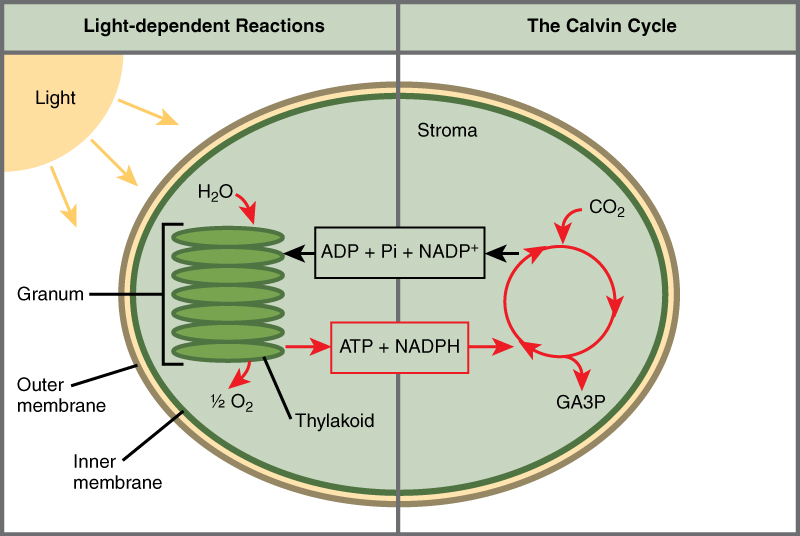10.1: Putting photosynthesis into context
- Page ID
- 69976
All living things require energy. Carbohydrates are storage molecules for energy. Living things access energy by breaking down carbohydrate molecules during the process of cellular respiration. Plants produce carbohydrates during photosynthesis. So if plants make carbohydrate molecules during photosynthesis, do they also perform cellular respiration? The answer is yes, they do. Although energy can be stored in molecules like ATP, carbohydrates (and lipids, which can also enter cellular respiration as a source of energy) are much more stable and efficient reservoirs for chemical energy. Photosynthetic organisms also carry out the reactions of respiration to harvest the energy that they have stored in carbohydrates during photosynthesis. Plants have mitochondria in addition to chloroplasts.
The overall reaction for photosynthesis:
\[\ce{6CO2 + 6H2O →⎯ C6H12O6 + 6O2}\nonumber\]
is the reverse of the overall reaction for cellular respiration:
\[\ce{6O2 + C6H12O6 → 6CO2 + 6H2O}\nonumber\]
Photosynthesis produces oxygen as a byproduct, and respiration produces carbon dioxide as a byproduct. In nature, there is no such thing as waste. Every single atom of matter is conserved, recycling indefinitely. Substances change form or move from one type of molecule to another, but never disappear (Figure \(\PageIndex{1}\)).
CO2 is no more a form of waste produced by respiration than oxygen is a waste product of photosynthesis. Both are byproducts of reactions that move on to other reactions. Photosynthesis absorbs energy from sunlight to build carbohydrates in the chloroplasts, and aerobic cellular respiration releases that stored energy by using oxygen to break down carbohydrates. Both organelles use electron transport chains to generate the energy necessary to drive other reactions. Photosynthesis and cellular respiration function in a biological cycle, allowing organisms to access life-sustaining energy that originates millions of miles away in a star.

There are two basic parts of photosynthesis: the light dependent reactions and the light independent reactions (also known as the Calvin cycle). During the light reactions, the energy from sunlight is stored in energy carrier molecules. These energy carrier molecules are then used to power the reactions of the Calvin cycle, where CO2 molecules are joined together to produce carbohydrates such as glucose.

Query \(\PageIndex{1}\)
References
Unless otherwise noted, images on this page are licensed under CC-BY 4.0 by OpenStax.
Text adapted from: OpenStax, Biology. OpenStax CNX. November 11, 2017. https://cnx.org/contents/GFy_h8cu@10...Photosynthesis

